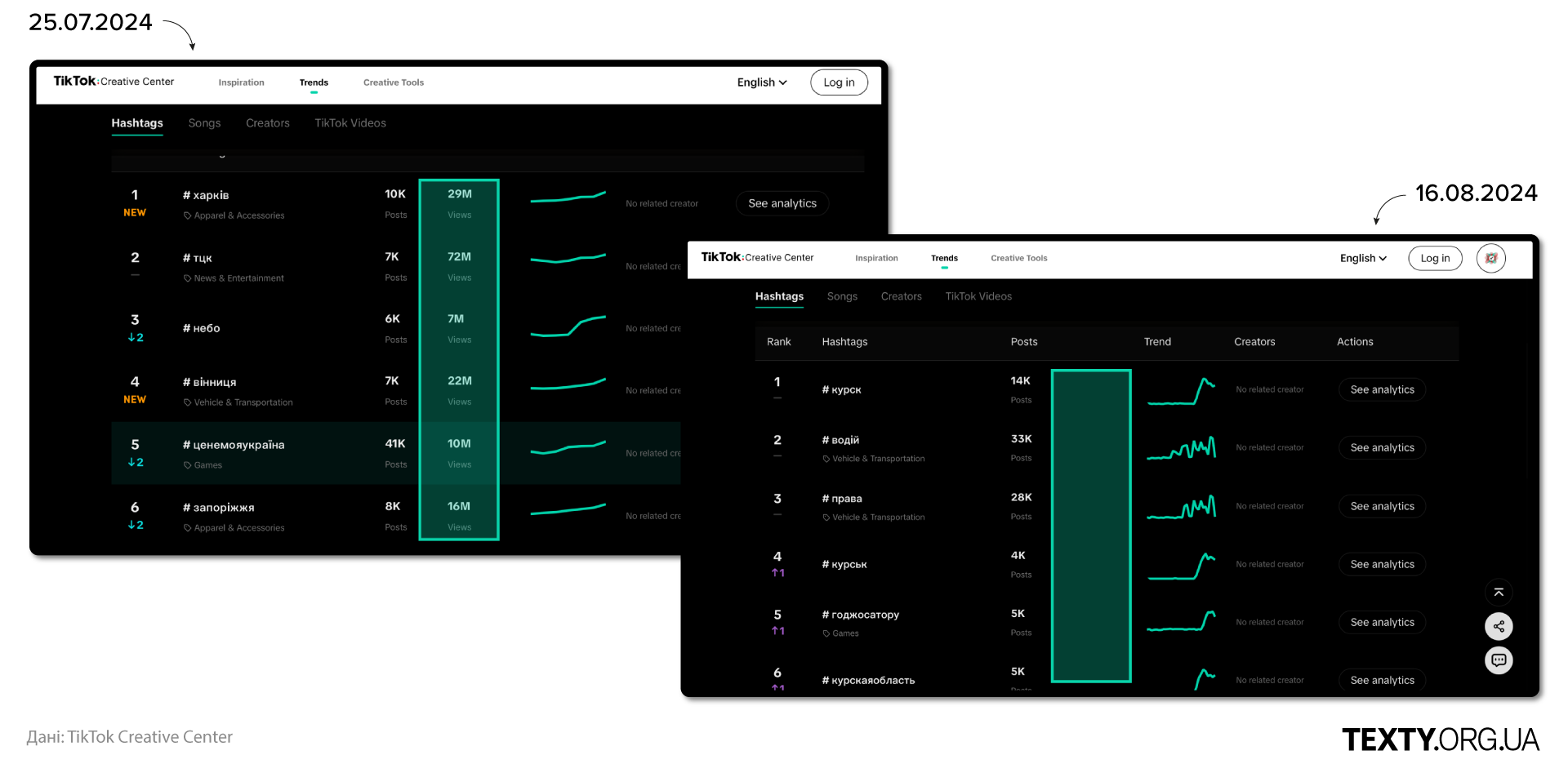TikTok says it counteracts disinformation but limits the ability to research and detect It
At the end of July, the TikTok Creative Center website (an analytical dashboard with the latest trends on the platform) showed the most popular hashtags in Ukraine and the number of views each has received. These statistics revealed that the network of artificial Russian bots had amassed 10 million views in just one week, indicating significant success. However, six months later, the view statistics vanished from the platform without a trace, suspiciously coinciding with the moment TikTok became aware of our investigation We know for sure that government agencies used the social network to block the bot farm after our article was published.

This tool — TikTok Creative Center — was initially developed for advertisers to gain insights, draw inspiration from best practices, discover life hacks, and stay updated on platform trends. However, it turned out that analyzing song and blogger rankings, researching popular hashtags, and tracking their frequency in videos are valuable not only for advertisers and content creators.
The statistics website section on the most popular hashtags has become a handy tool for analysts and disinformation researchers. With its help, one can identify successful and active information operations that have gone viral on the platform and gain insight into their scale.
With the help of this site, we discovered a network of Russian bots when we observed inauthentic behavior around the hashtag #recruitingoffice and noticed an equally interesting and completely artificial hashtag #it`snotmyukraine a few lines down in the ranking.
Today, when we tried to assess the activity of Ukrainians around the offensive in the Kursk region (and whether there are Russian fakes), we could not collect all the information because the social network removed it from public access.
We can see that the Kursk hashtag has hit the top of the rankings with 14 thousand videos over the past 30 days. However, we are not aware of the views number these videos received. We cannot check it. The column with the view data disappeared from the site without a trace.
This is not the first time TikTok has silently removed site functionality following a public discussion about the problems this platform causes.
Remove silently is easier than fighting misinterpretation
At the beginning of 2024, researchers monitoring the spread of certain geopolitical topics or the Israeli-Hamas war in TikTok noticed that the pages with statistics on thematic hashtags stopped working. At the same time, the Search button on the TikTok Creative Center page disappeared. From now on, all the information you can get is limited to a list of the 100 most popular hashtags. The emphasis is on entertainment categories such as children's pets or education. All socio-political topics are included in one (weird indeed) category, "News and entertainment" where hashtags like "TV show" or "marvel" can appear next to hashtags like "politics" or "news." Information about those hashtags that were not included in the list of the 100 most popular hashtags is no longer available to platform users.
The reason for these changes was criticism of the platform and accusations of pro-Palestinian bias. In response, TikTok published an explanation on its blog: direct comparison of hashtags is wrong and distorts the understanding of activity on the platform. Moreover, accusations of TikTok promoting a particular topic are unfounded, as they do not consider the principle of recommendation algorithms, which, instead of "taking sides," respond to user activity and preferences and offer them relevant content.
However, despite public discussion and debate, TikTok chose to remove the tools. Although useful for analysts, they can spoil the platform's image. And for TikTok, image and reputation are now almost paramount. And this is where the “trend” of fighting disinformation comes into play.
As innocent as a lamb
Recently, discussions about TikTok and disinformation have increasingly highlighted its efforts to "break out" of the “three T's" — Twitter (now X), Telegram, and TikTok — which were once lumped together under one letter to underscore its lax (if not nonexistent) moderation policies and the resulting risks of rampant disinformation and influence operations.
Today, while Telegram and Twitter do little to improve their reputations, the TikTok news is encouraging. After all, it has recently been very active in highlighting its fight against disinformation. The platform bans all bots exposed on their own or with the help of independent researchers and journalists, including 1,700 bots at the beginning or 12,800 at the end of 2023.
They first label and then restrict the distribution of videos from propaganda media controlled by governments (including Russia). Or they publish information about how they have strengthened their moderation algorithms ahead of the EU elections, removing almost 50,000 pieces of content with elements of dishonesty or disinformation. In October 2023, they claimed to have removed more than 925,000 videos related to the war between Israel and Hamas that contained fakes, violence, disinformation, or other signs of influence operations. They emphasize their proactivity, noting that 9 out of 10 hate speech videos are blocked even before a complaint is received.
But is that sufficient? Is countering disinformation on the platform as effective as possible and free of Chinese influence? We can never fully trust the integrity of large commercial platforms, as they are primarily driven by business interests and advertising revenue, with public benefit and security often taking a backseat. Nor can we verify the veracity of their statements based on internal information.
Besides, TikTok is a Chinese platform, and it may serve the interests of the Chinese Communist Party.
The only way to uncover the true nature of algorithms and their (dis)integrity is through independent investigations, which necessitate access to the platform’s content data. The perfect way is the official API (which is very limited for EU or US researchers and unavailable in Ukraine). As a last resort, an aggregated dashboard with statistics on popular topics can be used.
TikTok seems to be gradually depriving us of this limited tool as well.

